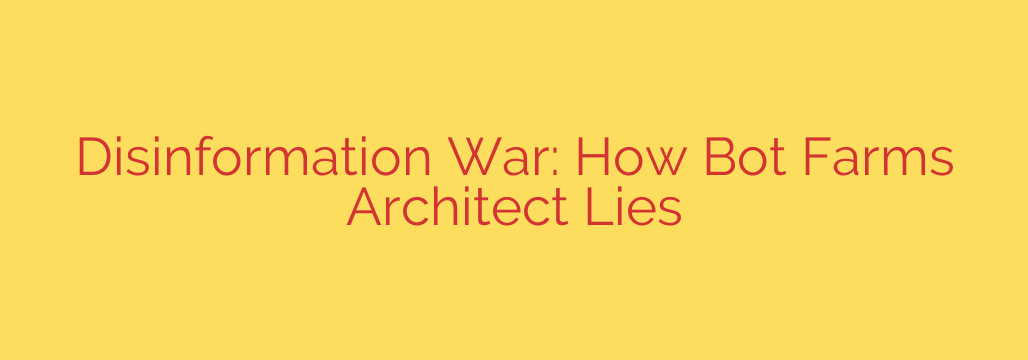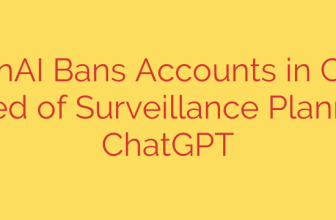
Bot Farms Explained: A Guide to Spotting and Resisting Online Disinformation
In the vast, interconnected world of social media and online news, not everything is as it seems. Beneath the surface of trending topics and viral posts lies a hidden digital battleground where automated networks, known as bot farms, work tirelessly to manipulate public opinion and spread false narratives. Understanding how these operations function is the first step in defending yourself against their influence.
A bot farm is not a physical place but a network of automated social media accounts controlled by a single entity. Think of it as a digital puppet master pulling the strings on hundreds, or even thousands, of fake profiles. These accounts are designed to mimic real users, but their goal is to amplify specific messages on a massive scale, creating the illusion of widespread, organic support for a particular idea, product, or political candidate.
The Goals of Online Disinformation Campaigns
Bot farms are sophisticated tools used to achieve specific, often malicious, objectives. While their tactics may vary, their primary goals typically fall into a few key categories:
- Influencing Public Opinion: By flooding social media with coordinated messages, bot farms can artificially make a fringe opinion seem mainstream. This is frequently used during elections or major social events to sway public perception, sow division, and erode trust in democratic institutions.
- Commercial Manipulation: Unscrupulous businesses use bot farms to post fake positive reviews for their products or services while simultaneously launching smear campaigns against competitors with negative ones. They can also create artificial hype around a stock or cryptocurrency to manipulate its value.
- Spreading Propaganda and Falsehoods: Hostile state actors and malicious groups use these networks to disseminate propaganda and outright lies. The goal is to create chaos, undermine trust in credible news sources, and promote a specific political agenda.
- Creating Artificial Engagement: Bot accounts are often sold as a service to influencers or brands looking to inflate their follower counts, likes, and comments. This fake engagement can mislead advertisers and consumers about a profile’s true reach and popularity.
How Bot Farms Operate in the Shadows
The effectiveness of a bot farm lies in its ability to operate covertly, making its activity appear authentic. They achieve this through a combination of technology and strategy.
First, they create thousands of fake personas. These profiles often use stolen or AI-generated profile pictures, generic names, and minimal personal information. To appear more legitimate, some bots may slowly build a history by reposting popular news articles or memes before being activated for a specific campaign.
Next, they engage in automated amplification. When a specific message needs to be promoted, all bots in the network are directed to like, share, and comment on it simultaneously. This sudden surge of activity tricks social media algorithms into thinking the content is trending, pushing it onto the feeds of real users.
Finally, they practice coordinated inauthenticity. Bots will often reply to each other’s posts to create the illusion of a genuine conversation. They swarm the comment sections of legitimate news outlets or public figures to drown out real debate and push their designated narrative. This tactic, often called “astroturfing,” manufactures a false sense of grassroots consensus.
Your Toolkit for Spotting a Bot Account
While bot operators are constantly evolving their methods, there are several red flags that can help you identify a fake account. Being able to spot a bot is a critical skill for any modern internet user.
- Suspicious Profile Details: Look for generic or nonsensical usernames (e.g., “David73950218”). Check the profile picture with a reverse image search; it’s often a stock photo or a picture stolen from an unsuspecting person’s profile. A new account with very few followers but that is following thousands of others is a major warning sign.
- Hyperactive Posting: No real person posts 24 hours a day. If you see an account sharing content hundreds of times a day at all hours, it is almost certainly automated.
- Repetitive or Off-Topic Content: Bots are programmed with a narrow set of instructions. They often post the exact same message, link, or reply over and over again. Their comments may also be completely irrelevant to the original post they are replying to.
- Grammatical Errors and Unnatural Language: While AI is improving, many bots still use awkward phrasing or make consistent grammatical mistakes that a native speaker would not.
How to Protect Yourself and Fight Back
Awareness is your best defense against disinformation. By adopting a more critical approach to the information you consume, you can protect yourself and help maintain a healthier online environment.
- Always Verify the Source: Before you share, like, or even believe a piece of information, ask yourself where it came from. Is it a reputable news organization with a history of journalistic integrity, or is it an anonymous blog that just appeared last week? Check for primary sources whenever possible.
- Practice Critical Thinking: Be wary of content designed to provoke a strong emotional reaction, like outrage or fear. Manipulators know that emotional content gets shared more quickly and with less scrutiny. Take a moment to pause and think before you engage.
- Report Suspicious Activity: All major social media platforms have tools to report spam and fake accounts. When you identify a bot, use the report function. This helps platforms identify and shut down entire bot networks.
- Diversify Your Information Diet: Avoid getting your news from a single source or social media feed. Actively seek out different perspectives from a variety of credible outlets to get a more complete picture of any given issue.
In the ongoing war against disinformation, individual vigilance is our most powerful weapon. By learning to recognize the tactics of bot farms and approaching online content with a healthy dose of skepticism, we can all play a part in promoting truth and resisting manipulation.
Source: https://www.helpnetsecurity.com/2025/10/07/bot-farms-misinformation-activity/








